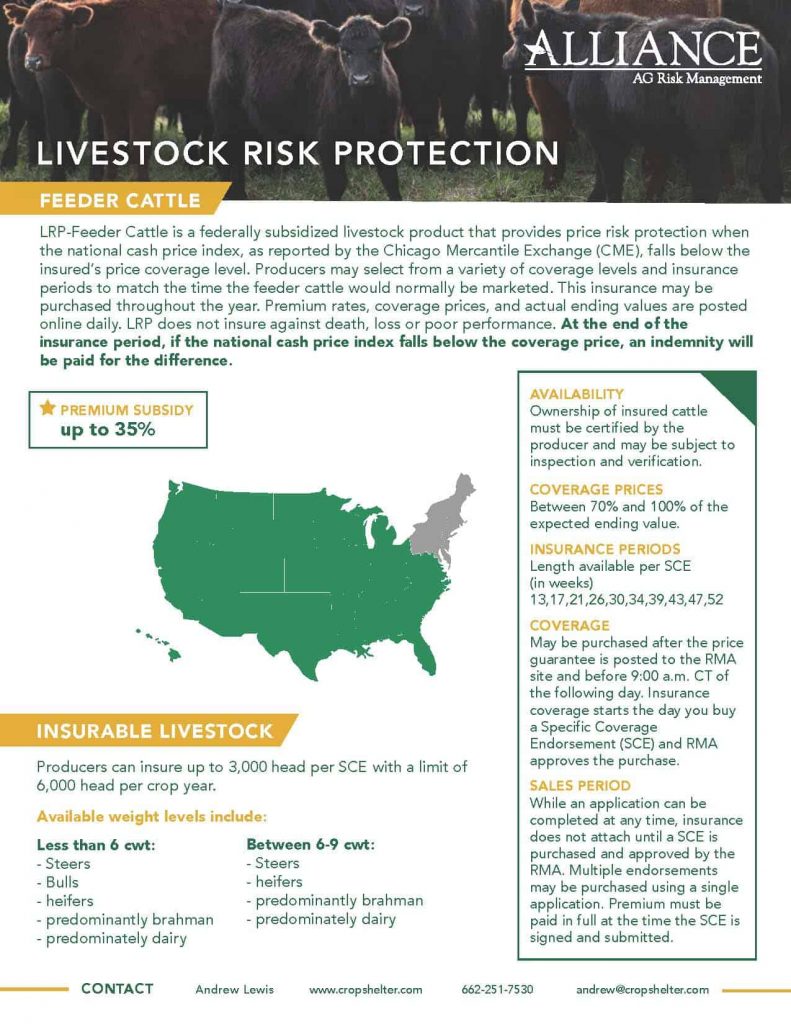Bagley Risk Management Solutions: Your Guard Versus Unpredictability
Bagley Risk Management Solutions: Your Guard Versus Unpredictability
Blog Article
Comprehending Animals Danger Security (LRP) Insurance: A Comprehensive Guide
Browsing the realm of livestock threat defense (LRP) insurance coverage can be an intricate endeavor for numerous in the farming sector. From how LRP insurance coverage operates to the numerous coverage options available, there is much to uncover in this extensive overview that might potentially shape the method livestock manufacturers come close to danger administration in their organizations.

How LRP Insurance Coverage Works
Occasionally, comprehending the auto mechanics of Animals Threat Defense (LRP) insurance can be complicated, however damaging down just how it functions can give clarity for farmers and ranchers. LRP insurance is a danger administration device made to protect livestock producers versus unanticipated rate decreases. It's vital to keep in mind that LRP insurance policy is not a revenue guarantee; instead, it concentrates only on rate threat security.
Eligibility and Protection Options

When it pertains to coverage alternatives, LRP insurance policy supplies manufacturers the versatility to choose the insurance coverage degree, protection period, and recommendations that best suit their risk management demands. Protection degrees commonly range from 70% to 100% of the expected ending worth of the insured animals. Producers can likewise pick protection periods that straighten with their manufacturing cycle, whether they are guaranteeing feeder livestock, fed livestock, swine, or lamb. Recommendations such as price risk security can better tailor coverage to protect against unfavorable market changes. By comprehending the qualification standards and coverage options offered, animals manufacturers can make enlightened choices to manage danger properly.
Pros and Disadvantages of LRP Insurance Policy
When assessing Animals Threat Security (LRP) insurance coverage, it is necessary for livestock manufacturers to consider the downsides and advantages fundamental in this risk monitoring tool.

One of the primary advantages of LRP insurance coverage is its capacity to offer security versus a decline in livestock costs. Additionally, LRP insurance coverage provides a degree of flexibility, allowing producers to customize coverage levels and plan periods to match their details demands.
One constraint of LRP insurance is that it does not shield versus all kinds of dangers, such as disease episodes or natural disasters. It is critical for producers to carefully analyze their private risk direct exposure and financial scenario to figure out if LRP insurance is the ideal risk monitoring tool for their procedure.
Understanding LRP Insurance Coverage Premiums

Tips for Maximizing LRP Advantages
Making best use of the benefits of Livestock Danger Defense (LRP) insurance needs calculated preparation and aggressive risk management - Bagley Risk Management. To maximize your LRP protection, take into consideration the adhering to tips:
Frequently Examine Market Problems: Keep educated concerning market fads and rate variations in the animals market. By keeping an eye on these aspects, you can make educated choices about when to buy LRP coverage to shield against prospective losses.
Set Realistic Coverage Levels: When choosing protection levels, consider your production costs, market price of livestock, and possible threats - Bagley Risk Management. Establishing practical insurance coverage degrees makes certain that you are sufficiently secured without overpaying for unnecessary insurance
Diversify Your Coverage: As opposed to relying entirely on LRP insurance, think about expanding your threat management methods. Incorporating LRP with other risk monitoring devices such as futures contracts or options can supply detailed protection against market uncertainties.
Evaluation and Change Protection Routinely: As market problems alter, periodically review your LRP protection to ensure it straightens with your current danger direct exposure. Changing coverage degrees and timing of acquisitions can assist optimize your danger protection approach. By complying with these tips, you can take full advantage of the benefits of LRP insurance and secure your livestock operation versus unexpected threats.
Conclusion
To conclude, livestock danger protection (LRP) insurance coverage is a valuable device for farmers to take care of the monetary threats connected with their livestock procedures. By understanding just how LRP functions, eligibility and protection alternatives, as her comment is here well as the benefits and drawbacks of this insurance policy, farmers can make informed choices to his response protect their incomes. By meticulously considering LRP premiums and carrying out approaches to optimize benefits, farmers can reduce prospective losses and make certain the sustainability of their operations.
Livestock manufacturers interested in obtaining Animals Risk Security (LRP) insurance can check out an array of eligibility requirements and coverage choices tailored to their details animals procedures.When it comes to insurance coverage options, LRP insurance policy supplies manufacturers the adaptability to pick the coverage level, coverage duration, and recommendations that ideal match their threat monitoring demands.To realize the intricacies of Animals Risk Defense (LRP) insurance policy totally, understanding the variables influencing LRP insurance coverage premiums is crucial. LRP insurance coverage premiums are identified by numerous elements, including the coverage degree selected, the anticipated rate of animals at the end of the coverage period, the kind of livestock being insured, and the size of the coverage period.Review and Readjust Insurance Coverage On a regular basis: As market conditions change, occasionally examine your LRP protection to ensure it aligns with your current danger exposure.
Report this page